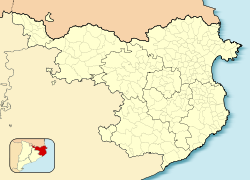Roses, Girona
| Roses | |||
|---|---|---|---|
| Municipality | |||
 |
|||
|
|||
| Location in Catalonia | |||
| Coordinates: 42°15′47″N 3°10′59″E / 42.26306°N 3.18306°ECoordinates: 42°15′47″N 3°10′59″E / 42.26306°N 3.18306°E | |||
| Country | Spain | ||
| Community | Catalonia | ||
| Province | Girona | ||
| Comarca | Alt Empordà | ||
| Government | |||
| • Mayor | Montse Mindan Cortada (2015) | ||
| Area | |||
| • Total | 45.9 km2 (17.7 sq mi) | ||
| Elevation | 5 m (16 ft) | ||
| Population (2015) | |||
| • Total | 19,575 | ||
| • Density | 430/km2 (1,100/sq mi) | ||
| Demonym(s) | Rosinques | ||
| Website | www |
||
Roses (Catalan pronunciation: [ˈrɔzəs], Spanish: Rosas, Spanish pronunciation: [ˈrosas]) is a municipality in the comarca of the Alt Empordà, located on the Costa Brava, in Catalonia, Spain.
It is the site of former bishopric Rotdon, now a Latin Catholic titular see.
It is situated on the coast at the northern end of the Gulf of Roses, and is an important fishing port and tourist centre. The C-260 road links the town with Figueres.
The origins of Roses (Greek: Rhode) are disputed. A popular theory holds it was founded in the 8th century BC by Greek colonists from Rhodes. It seems more probable that it was founded in the 5th century BC by Greeks from Massalia (Marseilles), perhaps with an admixture of colonists from neighbouring Emporion (today's Empúries). Remains of the Greek settlement can still be seen. Remains from the Roman period go back to the 2nd century BC and continue well into Christian times with a paleochristian church and necropolis. After the collapse of Roman power the town seems to have been abandoned, but a fortified settlement from the Visigothic period has been excavated on the nearby Puig Rom.
The mediaeval town grew around the monastery of Santa Maria de Roses (mentioned since 944). Its jurisdiction was shared by the abbots of Santa Maria de Roses and the counts of Empúries. In 1402 the county of Empúries was incorporated into the Crown of Aragon and Roses acquired the right to organize its own municipal government and economy.
...
Wikipedia




